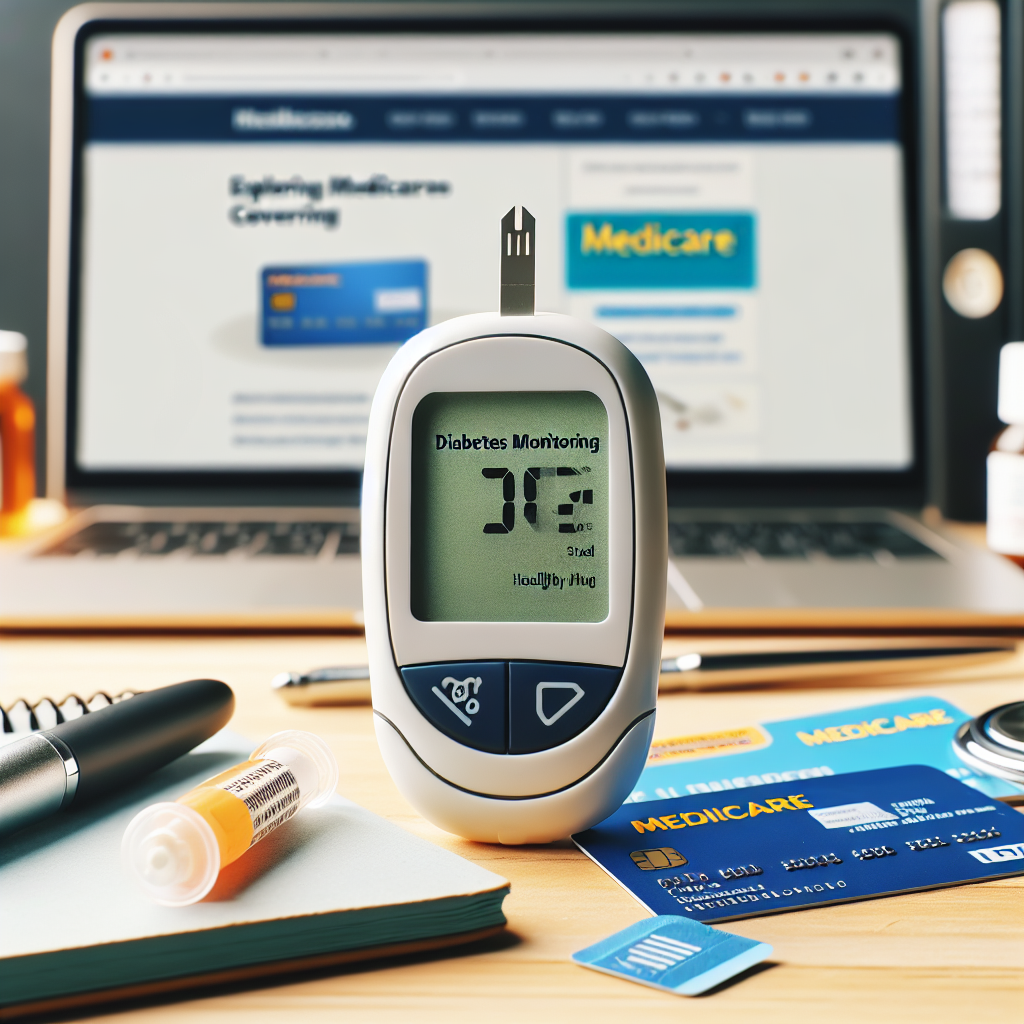Are you or a loved one living with diabetes and in need of frequent monitoring? Look no further than exploring Medicare coverage for diabetes monitoring. Medicare offers a range of coverage options for essential monitoring supplies and services to help manage the disease effectively. From blood glucose meters to test strips, lancets, and even diabetes self-management training, Medicare has you covered. Understanding what is included in your coverage can make all the difference in effectively managing your diabetes and improving your overall quality of life. Let’s dive into the world of Medicare coverage for diabetes monitoring and make informed decisions for your health.
Understanding Medicare Coverage for Diabetes Monitoring

Medicare coverage for diabetes monitoring plays a crucial role in ensuring that individuals with diabetes have access to necessary tools and resources to manage their condition effectively. Understanding the specifics of what Medicare covers in terms of diabetes monitoring equipment is essential for beneficiaries to make informed decisions about their healthcare needs.
Overview of Medicare coverage for diabetes monitoring
- Medicare Part B typically covers diabetes monitoring equipment and supplies for beneficiaries diagnosed with diabetes. This coverage includes blood glucose monitors, test strips, lancet devices, and lancets.
- Medicare may also cover continuous glucose monitors (CGMs) for individuals who meet specific eligibility criteria. CGMs provide real-time glucose readings and help individuals track their blood sugar levels more effectively.
- It is important for beneficiaries to consult with their healthcare provider to determine the most suitable monitoring equipment for their individual needs, as coverage may vary based on the type of equipment prescribed.
Types of diabetes monitoring equipment covered by Medicare
- Blood glucose monitors: These devices are essential for individuals with diabetes to check their blood sugar levels regularly. Medicare covers the cost of blood glucose monitors, which are typically used in conjunction with test strips to measure blood glucose levels accurately.
- Test strips: Test strips are disposable strips used in blood glucose monitors to measure blood sugar levels. Medicare provides coverage for a certain quantity of test strips per month, as prescribed by a healthcare provider.
- Lancet devices and lancets: Lancet devices are used to obtain a small drop of blood for testing, while lancets are the small needles that prick the skin. Both devices are covered by Medicare to facilitate blood glucose monitoring for individuals with diabetes.
Importance of regular monitoring for individuals with diabetes
- Regular monitoring of blood sugar levels is crucial for individuals with diabetes to manage their condition effectively and prevent complications.
- By tracking blood sugar levels regularly, individuals can make informed decisions about their diet, medication, and lifestyle choices to maintain optimal blood glucose control.
- Medicare coverage for diabetes monitoring equipment helps alleviate the financial burden associated with managing diabetes, making it more accessible for beneficiaries to monitor their condition consistently.
Medicare covers various types of diabetes monitoring equipment to help beneficiaries manage their condition effectively. The following are the key types of equipment covered by Medicare: - Blood Glucose Monitors: These devices are essential for individuals with diabetes to measure their blood sugar levels regularly. Medicare typically covers the cost of a blood glucose monitor, which is a crucial tool for monitoring and managing diabetes.
- Test Strips: Test strips are used in conjunction with blood glucose monitors to provide accurate blood sugar readings. Medicare often covers the cost of these test strips, allowing beneficiaries to test their blood sugar levels multiple times a day as recommended by healthcare providers.
- Lancets: Lancets are small, sharp needles used to prick the skin for blood glucose testing. These are also typically covered by Medicare, ensuring that beneficiaries have access to the necessary supplies for monitoring their diabetes.
- Continuous Glucose Monitoring Systems: Medicare may cover continuous glucose monitoring systems for eligible beneficiaries. These systems offer real-time glucose readings throughout the day, providing valuable data to help individuals make informed decisions about their diabetes management.
Overall, Medicare’s coverage of diabetes monitoring equipment plays a crucial role in supporting beneficiaries in effectively managing their diabetes and maintaining optimal health.

Eligibility for Medicare Coverage for Diabetes Monitoring
Medicare coverage for diabetes monitoring is available to individuals who meet specific criteria set by the program. To be eligible for Medicare coverage for diabetes monitoring, individuals must:
- Have a formal diagnosis of diabetes: Medicare coverage for diabetes monitoring is typically reserved for individuals who have been diagnosed with diabetes by a healthcare provider. This diagnosis is necessary to establish the medical necessity of monitoring equipment and supplies.
- Be enrolled in Medicare Part B: In order to access coverage for diabetes monitoring, individuals must be enrolled in Medicare Part B. This part of Medicare covers outpatient services, including durable medical equipment like glucose monitors and testing strips.
- Meet specific requirements for coverage: Medicare sets out detailed requirements for coverage of diabetes monitoring equipment. These requirements may include obtaining a prescription from a healthcare provider, using approved suppliers, and demonstrating the need for monitoring equipment to manage the individual’s diabetes effectively.
Overall, eligibility for Medicare coverage for diabetes monitoring is contingent upon meeting these criteria and following the guidelines set by the program to ensure access to necessary monitoring equipment and supplies.
Criteria for Medicare Coverage for Diabetes Monitoring
- Diagnosis of diabetes by a healthcare provider: In order to be eligible for Medicare coverage for diabetes monitoring, individuals must have a documented diagnosis of diabetes from a healthcare provider. This diagnosis serves as the basis for the necessity of monitoring equipment to manage the condition effectively.
- Medical necessity for monitoring equipment: Medicare coverage for diabetes monitoring is contingent upon the medical necessity of monitoring equipment. This includes devices such as blood glucose meters, test strips, lancets, and continuous glucose monitors. The healthcare provider must determine that these tools are essential for managing the individual’s diabetes and maintaining their health.

– Frequency of monitoring prescribed by a healthcare provider: Medicare coverage for diabetes monitoring also takes into account the frequency of monitoring prescribed by a healthcare provider. The provider will recommend how often the individual should test their blood glucose levels based on factors such as their type of diabetes, treatment plan, and overall health status. Medicare will typically cover the costs of monitoring supplies based on the frequency deemed medically necessary by the healthcare provider.
Understanding Medicare Costs for Diabetes Monitoring
When it comes to Medicare coverage for diabetes monitoring, it is essential to have a comprehensive understanding of the associated costs to ensure optimal management of the condition. Below are key factors to consider regarding Medicare costs for diabetes monitoring:
- Out-of-pocket costs for diabetes monitoring equipment
Medicare Part B typically covers certain diabetes monitoring equipment, such as blood sugar monitors, test strips, lancets, and glucose control solutions. However, beneficiaries may still incur out-of-pocket costs, including deductibles, copayments, or coinsurance for these supplies. It is crucial for individuals with diabetes to be aware of these potential expenses to effectively budget for their healthcare needs.
- Coverage limitations and restrictions
While Medicare provides coverage for essential diabetes monitoring equipment, there may be limitations and restrictions on the frequency or quantity of supplies covered. For example, Medicare may limit the number of test strips or lancets provided per month, requiring beneficiaries to adhere to these guidelines to avoid additional out-of-pocket expenses. Understanding these coverage limitations is vital for individuals to plan their diabetes management effectively within the confines of Medicare guidelines.
- Medicare Supplement Insurance for additional coverage
To address potential gaps in Medicare coverage for diabetes monitoring, beneficiaries have the option to purchase a Medicare Supplement Insurance plan, also known as Medigap. These supplemental plans can help cover out-of-pocket costs, such as deductibles, copayments, or coinsurance related to diabetes monitoring supplies. By enrolling in a Medigap plan, individuals with diabetes can enhance their coverage and reduce financial burdens associated with managing their condition.
Out-of-Pocket Costs for Diabetes Monitoring Equipment
When it comes to Medicare coverage for diabetes monitoring equipment, beneficiaries often face out-of-pocket costs that can vary depending on the specific supplies needed. Here are some key points to consider regarding these expenses:
- Co-payments for Diabetes Monitoring Supplies: Medicare Part B typically covers 80% of the approved amount for diabetes monitoring supplies, such as blood glucose monitors, test strips, lancets, and glucose control solutions. However, beneficiaries are responsible for the remaining 20% of the costs, which can result in significant out-of-pocket expenses.
- Coverage Limits on the Number of Supplies Provided: Another factor to keep in mind is that Medicare may impose coverage limits on the quantity of diabetes monitoring supplies provided within a certain time frame. This means that beneficiaries may need to pay out of pocket for additional supplies if they exceed the allowed limit, adding to their overall expenses.
- Options for Reducing Out-of-Pocket Expenses: To help manage out-of-pocket costs for diabetes monitoring equipment, beneficiaries can consider enrolling in a Medicare Advantage plan that may offer additional coverage for supplies or a Medicare Supplement Insurance plan to help cover the remaining costs. Additionally, exploring different suppliers and comparing prices can also potentially save money on these essential diabetes management tools.
How to Maximize Medicare Coverage for Diabetes Monitoring
When it comes to managing diabetes, understanding how to maximize Medicare coverage for monitoring is essential for ensuring proper care and support. Here are some key strategies to help individuals make the most of their Medicare benefits:
- Utilizing preventive services under Medicare
Medicare covers a range of preventive services aimed at managing diabetes and its complications. By taking advantage of these services, individuals can stay proactive in their diabetes care. This includes services such as annual wellness visits, screenings for diabetes, and medical nutrition therapy. By regularly utilizing these preventive services, individuals can not only monitor their condition effectively but also potentially prevent the onset of complications.
- Working with healthcare providers to optimize coverage
Collaborating closely with healthcare providers is crucial in maximizing Medicare coverage for diabetes monitoring. Healthcare providers can help individuals navigate the complexities of Medicare coverage, recommend appropriate monitoring tools and supplies, and ensure that all necessary services are covered. By maintaining open communication with their healthcare team, individuals can receive personalized guidance on how to optimize their Medicare coverage for diabetes monitoring.
- Understanding the role of Medicare Advantage plans in diabetes management
Medicare Advantage plans, also known as Medicare Part C, offer an alternative way to receive Medicare benefits. These plans often provide additional coverage beyond original Medicare, including benefits related to diabetes management. Individuals with diabetes may find that Medicare Advantage plans offer more comprehensive coverage for monitoring supplies, medications, and other services. Understanding the specifics of Medicare Advantage plans and how they can support diabetes management is essential for maximizing coverage and ensuring comprehensive care.
Utilizing Preventive Services under Medicare
Medicare offers a range of preventive services to help individuals manage their diabetes effectively. These services are essential for maintaining overall health and well-being while managing the condition. It is crucial for beneficiaries to take advantage of these services to optimize their diabetes care and control.
Annual Wellness Visits
- Medicare covers annual wellness visits that include a comprehensive health assessment. During these visits, healthcare providers can assess the individual’s overall health status, review medical history, and discuss any concerns related to diabetes management.
- Annual wellness visits allow for the development of a personalized prevention plan that addresses the individual’s specific needs and risk factors. This plan may include recommendations for diabetes monitoring, lifestyle modifications, and preventive care measures.
- Regular annual wellness visits help track changes in health status over time, identify any emerging issues related to diabetes management, and adjust the treatment plan accordingly. By staying proactive and engaging in preventive care, beneficiaries can better control their diabetes and prevent complications.
Medical Nutrition Therapy
- Medicare covers medical nutrition therapy for beneficiaries with diabetes who meet certain criteria. This service involves individualized nutrition counseling provided by a registered dietitian or nutrition professional.
- Medical nutrition therapy aims to educate individuals about healthy eating habits, portion control, carbohydrate counting, and meal planning strategies specific to diabetes management.
- Through medical nutrition therapy, beneficiaries can learn how to make healthier food choices, manage blood sugar levels effectively, and improve overall well-being. This service plays a crucial role in diabetes management and can help prevent complications associated with the condition.
Diabetes Self-Management Training
- Medicare covers diabetes self-management training for beneficiaries diagnosed with diabetes. This training program helps individuals acquire the knowledge and skills necessary to manage their condition effectively on a day-to-day basis.
- Diabetes self-management training covers various topics such as monitoring blood sugar levels, administering insulin or medications, understanding the signs of high or low blood sugar, and making lifestyle adjustments to control diabetes.
- By participating in diabetes self-management training, beneficiaries can gain confidence in managing their condition, improve adherence to treatment plans, and enhance their quality of life. This training is an essential component of diabetes care and can lead to better health outcomes in the long run.
Resources for Navigating Medicare Coverage for Diabetes Monitoring
Navigating Medicare coverage for diabetes monitoring can be complex, but there are resources available to help individuals understand their benefits and options. Here are some key resources to consider:
- Medicare.gov: The official Medicare website is a valuable resource for information on coverage guidelines, eligibility requirements, and specific details about diabetes monitoring services. It provides up-to-date information on what is covered under different parts of Medicare, including Part B coverage for diabetes supplies and services.
- State Health Insurance Assistance Programs (SHIP): SHIP programs offer free counseling and assistance to Medicare beneficiaries, including guidance on understanding coverage options for diabetes monitoring. These programs are staffed by trained counselors who can provide personalized assistance to help individuals navigate the complexities of Medicare coverage.
- Community resources for diabetes management support: Many communities offer resources and support services for individuals managing diabetes. These resources may include support groups, educational workshops, and local health clinics that provide diabetes monitoring services. Connecting with these community resources can help individuals access additional support and information to complement their Medicare coverage.
FAQs: Exploring Medicare Coverage for Diabetes Monitoring
Does Medicare cover the cost of blood glucose monitors for diabetes management?
Yes, Medicare Part B covers the cost of blood glucose monitors for diabetes management. This includes the monitor itself, testing strips, lancets, and lancet devices. Medicare also covers the cost of necessary supplies for blood sugar testing.
Will Medicare cover the cost of continuous glucose monitoring (CGM) devices for diabetes management?
Medicare does cover the cost of CGM devices for individuals with diabetes who meet certain criteria. Coverage is available under Medicare Part B for those who need frequent blood sugar testing and meet specific eligibility requirements. It is important to speak with your healthcare provider to determine if you qualify for coverage.
Does Medicare cover necessary diabetic education and training for using monitoring devices?
Yes, Medicare covers necessary diabetic education and training for using monitoring devices. This includes education on how to properly use and maintain your blood glucose monitor, as well as instruction on interpreting your blood sugar readings. This education is essential for effective diabetes management.
Is there any out-of-pocket cost for Medicare beneficiaries using diabetes monitoring equipment?
Medicare beneficiaries may still be responsible for certain out-of-pocket costs when using diabetes monitoring equipment. This can include co-payments or deductibles, depending on your specific Medicare coverage. It is important to review your plan details and speak with your healthcare provider to understand any potential out-of-pocket costs.